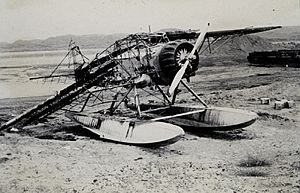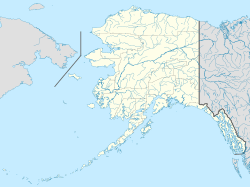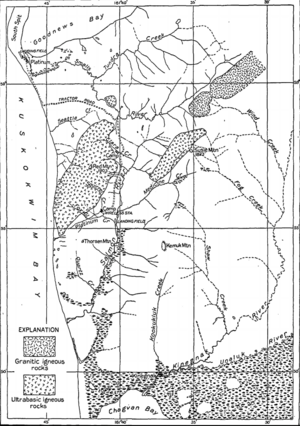Platinum, Alaska facts for kids
Quick facts for kids
Platinum
Arviiq
|
|
|---|---|

Destroyed airplane at Platinum, 1948
|
|
| Country | United States |
| State | Alaska |
| Census Area | Bethel |
| Incorporated | February 13, 1975 |
| Area | |
| • Total | 47.31 sq mi (122.53 km2) |
| • Land | 47.27 sq mi (122.41 km2) |
| • Water | 0.05 sq mi (0.12 km2) |
| Elevation | 13 ft (4 m) |
| Population
(2020)
|
|
| • Total | 55 |
| • Density | 1.16/sq mi (0.45/km2) |
| Time zone | UTC-9 (Alaska (AKST)) |
| • Summer (DST) | UTC-8 (AKDT) |
| ZIP codes |
99651
|
| Area code | 907 |
| FIPS code | 02-61080 |
Platinum (which is called Arviiq in the local language) is a small city in Bethel Census Area, Alaska, United States. In 2020, about 55 people lived there. The city's name comes from the valuable metal found nearby.
Contents
Where is Platinum Located?
Platinum is located at 59°00′47″N 161°48′59″W / 59.01306°N 161.81639°W. It sits on Goodnews Bay, right next to where the Small River flows into the bay. It is about eleven miles southwest of Goodnews and the Kilbuck Mountains.
The city covers a total area of about 47.31 square miles (122.53 square kilometers). Most of this area is land, with only a tiny bit being water.
What is the Weather Like in Platinum?
Platinum has a subarctic climate. This means it has short, cool, and rainy summers. The winters are long and very cold, with a good amount of snow, especially in March.
| Climate data for Platinum, Alaska (1939-1964) | |||||||||||||
|---|---|---|---|---|---|---|---|---|---|---|---|---|---|
| Month | Jan | Feb | Mar | Apr | May | Jun | Jul | Aug | Sep | Oct | Nov | Dec | Year |
| Record high °F (°C) | 52 (11) |
47 (8) |
46 (8) |
53 (12) |
65 (18) |
79 (26) |
82 (28) |
73 (23) |
68 (20) |
63 (17) |
48 (9) |
44 (7) |
82 (28) |
| Mean maximum °F (°C) | 38.8 (3.8) |
38.4 (3.6) |
38.7 (3.7) |
44.3 (6.8) |
57.0 (13.9) |
64.6 (18.1) |
69.6 (20.9) |
65.3 (18.5) |
60.0 (15.6) |
50.5 (10.3) |
41.9 (5.5) |
37.5 (3.1) |
70.7 (21.5) |
| Mean daily maximum °F (°C) | 20.8 (−6.2) |
22.1 (−5.5) |
24.2 (−4.3) |
33.6 (0.9) |
44.8 (7.1) |
53.8 (12.1) |
57.0 (13.9) |
56.5 (13.6) |
51.6 (10.9) |
39.8 (4.3) |
28.6 (−1.9) |
18.8 (−7.3) |
37.6 (3.1) |
| Daily mean °F (°C) | 14.4 (−9.8) |
15.0 (−9.4) |
17.4 (−8.1) |
27.7 (−2.4) |
39.0 (3.9) |
47.7 (8.7) |
51.6 (10.9) |
51.7 (10.9) |
46.0 (7.8) |
34.6 (1.4) |
23.1 (−4.9) |
12.1 (−11.1) |
31.7 (−0.2) |
| Mean daily minimum °F (°C) | 8.0 (−13.3) |
8.7 (−12.9) |
10.7 (−11.8) |
22.4 (−5.3) |
33.3 (0.7) |
41.6 (5.3) |
46.1 (7.8) |
46.9 (8.3) |
40.5 (4.7) |
29.3 (−1.5) |
17.6 (−8.0) |
5.8 (−14.6) |
25.9 (−3.4) |
| Mean minimum °F (°C) | −18.9 (−28.3) |
−18.8 (−28.2) |
−11.7 (−24.3) |
4.8 (−15.1) |
21.7 (−5.7) |
34.4 (1.3) |
39.3 (4.1) |
39.2 (4.0) |
28.8 (−1.8) |
14.7 (−9.6) |
−4.0 (−20.0) |
−16.9 (−27.2) |
−25.8 (−32.1) |
| Record low °F (°C) | −34 (−37) |
−32 (−36) |
−26 (−32) |
−11 (−24) |
2 (−17) |
31 (−1) |
32 (0) |
32 (0) |
22 (−6) |
6 (−14) |
−21 (−29) |
−29 (−34) |
−34 (−37) |
| Average precipitation inches (mm) | 1.07 (27) |
1.24 (31) |
1.28 (33) |
0.81 (21) |
1.28 (33) |
1.19 (30) |
2.10 (53) |
4.24 (108) |
3.73 (95) |
2.60 (66) |
1.56 (40) |
1.29 (33) |
22.38 (568) |
| Average snowfall inches (cm) | 7.4 (19) |
8.9 (23) |
10.0 (25) |
2.7 (6.9) |
0.6 (1.5) |
0.0 (0.0) |
0.0 (0.0) |
0.0 (0.0) |
0.0 (0.0) |
1.5 (3.8) |
4.0 (10) |
5.6 (14) |
40.6 (103) |
| Average precipitation days (≥ 0.01 in) | 9.8 | 9.6 | 10.8 | 8.5 | 11.0 | 9.6 | 12.9 | 18.6 | 17.7 | 15.0 | 10.2 | 9.3 | 143.0 |
| Average snowy days (≥ 0.1 in) | 5.6 | 6.3 | 7.9 | 3.9 | 0.9 | 0.0 | 0.0 | 0.0 | 0.0 | 2.0 | 3.8 | 5.7 | 36.1 |
| Source: NOAA | |||||||||||||
History of Platinum
The city of Platinum got its name in the 1930s. This was because a lot of platinum ore was found in the area. By 1937, it became a busy mining town. It had a roadhouse, two trading posts, and about 50 people living there. A post office was set up in 1935. Before this, there was an older Inuit village called Arviq, but it had been left empty. Platinum officially became a city in 1975.
In 1937, a company called Ray Petersen Flying Service got a special job. They were hired to fly for the Goodnews Bay platinum and iridium mine. They transported miners and supplies from their base in Bethel, Alaska.
During World War II, the Alaska Territorial Guard helped protect Platinum. This was because Platinum was the only place in the Western Hemisphere that had platinum, a very important metal for military use.
People of Platinum
| Historical population | |||
|---|---|---|---|
| Census | Pop. | %± | |
| 1940 | 45 | — | |
| 1950 | 72 | 60.0% | |
| 1960 | 43 | −40.3% | |
| 1970 | 55 | 27.9% | |
| 1980 | 55 | 0.0% | |
| 1990 | 64 | 16.4% | |
| 2000 | 41 | −35.9% | |
| 2010 | 61 | 48.8% | |
| 2020 | 55 | −9.8% | |
| U.S. Decennial Census | |||
Platinum first appeared in the U.S. Census in 1940 as a village. It officially became a city in 1975.
In 2000, there were 41 people living in Platinum. Most of the people (about 90%) were Native American. About 7% were White.
The average household had about 2.41 people. The average family had about 2.90 people. The median age in the city was 32 years old.
Education in Platinum
The Lower Kuskokwim School District runs the Arviq School, which teaches students from kindergarten to 12th grade. The school closed in Spring 2001 because there weren't enough students. However, it reopened in October 2007. As of 2018, the Arviq School had 20 students.
Geology and Mining
In 1926, an Eskimo man named Walter Smith found what he thought was "white gold" near Fox Gulch. It turned out to be platinum! Later, in 1928, Charles Thorsen and Edward St. Clair also found platinum in other creeks.
Mining companies, like Goodnews Bay Mining Co. and Clara Creek Mining Co., started working in the area. They mined special deposits called placer deposits. These deposits contained a lot of platinum (60%) and also iridium (22%). The biggest piece of platinum found was 1.5 ounces.
The Goodnews Bay Mining Co. began using a large machine called a dragline excavator in 1934. They also started using a dredge in 1937 to dig for platinum. Between 1927 and 1937, a huge amount of platinum metals were found and collected from these mining operations.
See also
 In Spanish: Platinum (Alaska) para niños
In Spanish: Platinum (Alaska) para niños



